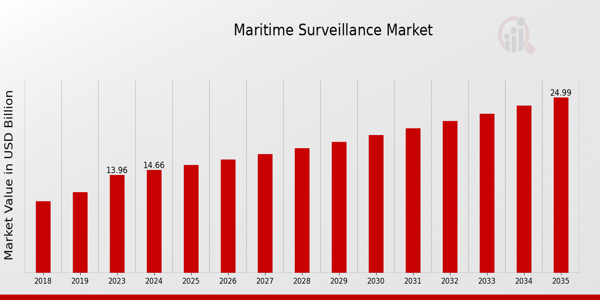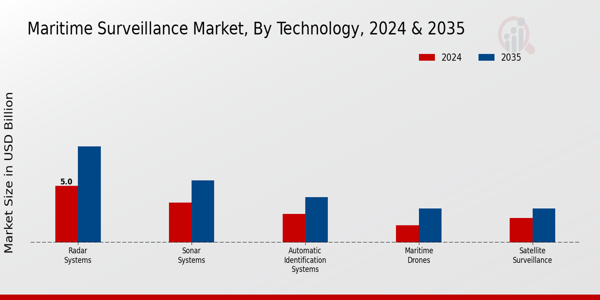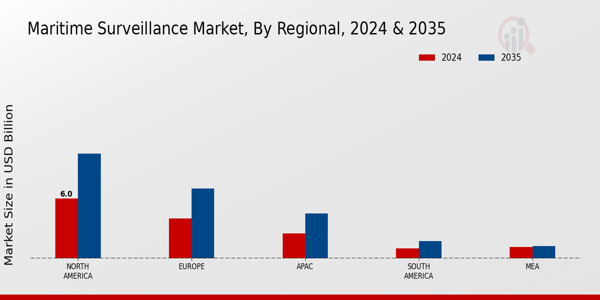Global Maritime Surveillance Market Overview
Maritime Surveillance Market Size was estimated at 13.96 (USD Billion) in 2023.The Maritime Surveillance Market is expected to grow from 14.66(USD Billion) in 2024 to 25.0 (USD Billion) by 2035. The Maritime Surveillance Market CAGR (growth rate) is expected to be around 4.97% during the forecast period (2025 - 2035).
Key Maritime Surveillance Market Trends Highlighted
Due to a mix of growing security concerns and technological improvements, the global maritime surveillance market is expanding significantly. Governments and organizations are investing in advanced surveillance systems in response to increased maritime safety rules and the need to combat illegal fishing, smuggling, and piracy.
Furthermore, the need for efficient monitoring solutions has increased due to the growth of international shipping routes and the increase in maritime trade. By improving prediction and reaction capabilities to maritime risks, the industry is being further driven forward by the integration of artificial intelligence and machine learning for data analysis.
There are numerous opportunities to be explored within this evolving market. The increasing emphasis on environmental monitoring, particularly with regard to illegal dumping and vessel emissions, presents a chance for companies to develop sustainable surveillance solutions.
Furthermore, the growth of the Internet of Things (IoT) in maritime applications allows for improved connectivity and real-time monitoring, paving the way for innovation.
Regions that are investing in maritime infrastructure also create demand for integrated surveillance systems to ensure safety and compliance. Recent trends show a rising inclination towards automation in maritime surveillance.
Automated drones and remotely operated vehicles are being increasingly adopted for surveillance tasks, leading to more efficient operations. The collaboration between private sector companies and government agencies is also on the rise, improving data sharing and enhancing security protocols.
The rising importance of cybersecurity in protecting maritime data systems is becoming notably prominent. All these factors are shaping the future of the Global Maritime Surveillance Market, making it an area of significant interest for stakeholders seeking growth and security in maritime operations.

Source: Primary Research, Secondary Research, MRFR Database and Analyst Review
Maritime Surveillance Market Drivers
Increasing Maritime Security Concerns
In recent years, the need for robust maritime security has gained significant attention due to the escalating threats posed by piracy, smuggling, and acts of terrorism at sea. Governments and maritime agencies around the globe are investing heavily in advanced surveillance technologies to ensure the safety and security of maritime routes and assets.
The Global Maritime Surveillance Market is witnessing a surge in demand for integrated surveillance systems that provide real-time monitoring and threat assessment capabilities.
The focus on protecting critical infrastructure, shipping lanes, and coastal areas has led to increased collaborations between government entities and private sector companies. This integrated approach aims to create comprehensive surveillance solutions that can address a wide range of security concerns, including illegal fishing, human trafficking, and environmental protection.
As stakeholders prioritize securing their maritime borders, the market for maritime surveillance is expected to expand steadily over the next decade. The increasing complexity of maritime operations necessitates the deployment of cutting-edge technologies such as radar, satellite imaging, and unmanned aerial vehicles (UAVs) to enhance situational awareness and response capabilities.
Furthermore, the growing trend of data sharing among agencies and countries will facilitate improved coordination in responding to maritime security threats. These developments are indicative of a market poised for significant growth as organizations seek effective solutions to combat emerging security challenges in the maritime industry.
Technological Advancements in Surveillance Systems
The technological landscape is evolving rapidly, and innovations in surveillance technologies are driving growth in the Global Maritime Surveillance Market. The development of advanced sensors, artificial intelligence, and machine learning algorithms has revolutionized maritime surveillance capabilities, enabling more accurate tracking and identification of vessels.
These technologies enhance the ability to detect anomalies, monitor large areas, and analyze vast amounts of data quickly. As new technologies become available, maritime operators and security agencies are keen to adopt solutions that provide a competitive edge in surveillance efficiency.
Growing Emphasis on Environmental Monitoring
With increasing concerns about climate change and environmental degradation, there is a growing emphasis on monitoring marine environments. The Global Maritime Surveillance Market is benefiting from initiatives aimed at protecting marine biodiversity, monitoring illegal dumping, and managing fishing activities.
Surveillance systems are being integrated with environmental monitoring tools to provide holistic solutions that not only enhance security but also promote sustainable practices in maritime operations. This dual focus on security and environmental stewardship is propelling market growth as stakeholders seek comprehensive surveillance solutions.
Maritime Surveillance Market Segment Insights:
Maritime Surveillance Market Technology Insights
The Global Maritime Surveillance Market experienced significant growth driven by advancements in Technology, which played a crucial role in ensuring maritime security and operational efficiency. The Technology segment encompassed diverse applications, including Radar Systems, Sonar Systems, Automatic Identification Systems, Maritime Drones, and Satellite Surveillance, each contributing uniquely to maritime safety and security.
Radar Systems held a majority share in the market, valued at 5.0 USD Billion in 2024, as they are widely utilized for object detection and tracking, thus providing critical situational awareness. Following this, Sonar Systems, with a valuation of 3.5 USD Billion in 2024, played a vital role in underwater surveillance and navigation, especially in anti-submarine warfare and environmental monitoring.
Meanwhile, Automatic Identification Systems, valued at 2.5 USD Billion, enhance ship tracking and collision avoidance, making them significant for improving maritime traffic management and safety.
Moreover, Maritime Drones gained traction, valued at 1.5 USD Billion in 2024, due to their capabilities in surveillance, reconnaissance, and search-and-rescue operations, proving their importance in extending the reach of maritime operations.
Lastly, Satellite Surveillance, valued at 2.16 USD Billion, was critical for global monitoring and intelligence gathering, helping to combat illegal fishing, piracy, and resource depletion.
The overall market growth was propelled by the rising concerns over maritime security, environmental protection, and regulatory mandates. However, challenges such as high initial investment costs and technological complexities exist.
Nevertheless, the increasing integration of AI and IoT in maritime surveillance presents numerous opportunities for market expansion and innovation. As the maritime industry continues to prioritize safety, the Technology segment stands poised for sustained growth, driven by the evolving needs and advancements in surveillance systems.

Source: Primary Research, Secondary Research, MRFR Database and Analyst Review
Maritime Surveillance Market Application Insights
The market segmentation encompasses critical areas such as Coastal Surveillance, Port Security, Search and Rescue Operations, Environmental Monitoring, and Traffic Management, each contributing to the overall market dynamics in unique ways. Coastal Surveillance plays a vital role in safeguarding territorial waters, while Port Security addresses the need for increased safety and monitoring in busy maritime hubs.
The Search and Rescue Operations application is crucial for effectively responding to emergencies at sea, showcasing the increasing focus on maritime safety. Environmental Monitoring has gained importance due to rising awareness of ecological impacts, ensuring compliance with international regulations.
Additionally, Traffic Management supports efficient maritime transport, which is essential for global trade. Collectively, these elements illustrate how the Global Maritime Surveillance Market thrives on improving security, safety, and environmental stewardship across maritime operations, reflecting vital trends that drive market growth.
Maritime Surveillance Market End Use Insights
The Global Maritime Surveillance Market is poised for substantial growth, reflecting its critical importance across various end-use applications. The market encompasses vital sectors such as Military, Commercial, and Government, each playing a significant role in the overall landscape.
Military applications dominate this market due to the increasing demand for advanced surveillance systems that ensure maritime security and address defense needs. The Commercial sector is flourishing as shipping and fishing industries seek enhanced monitoring to boost operational efficiency and safety in the vast maritime domain.
Government agencies are also crucial, utilizing maritime surveillance for border security and regulatory enforcement in coastal waters. The growing reliance on technology and data analytics in these sectors is driving demand as stakeholders seek to leverage Global Maritime Surveillance Market data for informed decision-making.
Despite challenges like data privacy and regulatory compliance, market opportunities arise from technological advancements and the escalating need for enhanced monitoring solutions, illustrating the dynamic nature of the Global Maritime Surveillance Market.
Maritime Surveillance Market System Type Insights
The market encompasses various system types, with Integrated Systems playing a crucial role due to their ability to combine multiple surveillance technologies into a cohesive solution, facilitating comprehensive threat detection and response capabilities.
Standalone Systems also contribute significantly, providing dedicated functionalities that address specific surveillance needs and ensuring ease of implementation in diverse maritime environments. Remote Sensing Systems further enhance surveillance capabilities by utilizing advanced satellite and drone technologies to cover vast areas and monitor real-time data.
The growing demand for these systems is driven by increasing maritime threats, advancements in technology, and the need for enhanced situational awareness. However, challenges such as high implementation costs and the integration of new technologies within existing infrastructures remain prevalent.
Overall, the Global Maritime Surveillance Market data reflects a promising trajectory, with significant growth anticipated as industry stakeholders prioritize robust surveillance solutions to counteract evolving maritime security challenges.
Maritime Surveillance Market Regional Insights
The Global Maritime Surveillance Market was poised for steady growth across various regions, showcasing diverse market dynamics. In 2024, North America led with a valuation of 6.0 USD Billion, reflecting its significant maritime assets and advanced technological frameworks that enhance surveillance capabilities.
Europe followed closely with a valuation of 4.0 USD Billion, where stringent regulations and ongoing security initiatives drive demand. The APAC region, valued at 2.5 USD Billion, gained traction due to the rising maritime activities and the increasing need for enhanced safety measures.
South America and MEA, valued at 1.0 USD Billion and 1.16 USD Billion respectively, represented emerging markets where investments in maritime surveillance solutions are essential to address growing security concerns.
The dominance of North America and Europe underscored their critical role in the Global Maritime Surveillance Market revenue, while APAC's growing influence highlighted the region's vital opportunities for market expansion.
Each region contributed uniquely to the Global Maritime Surveillance Market segmentation, driven by regional challenges, economic conditions, and technological advancements, which ultimately shape the market's landscape.

Source: Primary Research, Secondary Research, MRFR Database and Analyst Review
Maritime Surveillance Market Key Players and Competitive Insights:
The Global Maritime Surveillance Market is a rapidly evolving sector driven by advancements in technology, an increased focus on maritime security, and the need for enhanced operational efficiency in naval defense systems.
The market is characterized by a diverse range of providers offering tools and services that enhance the monitoring of maritime activities, covering various applications from naval operations to commercial shipping safety.
In this dynamic landscape, companies are continuously innovating and strategizing to capture market share, with competition centered around the development of advanced surveillance systems, including radar, sonar, and unmanned vehicles.
Regulatory frameworks related to maritime security further contribute to competitive dynamics, pushing companies to develop solutions that ensure compliance while enhancing situational awareness and response capabilities in maritime environments.
Vard Group is recognized for its robust presence in the Global Maritime Surveillance Market, particularly noted for its innovative shipbuilding capabilities that help create platforms equipped with advanced surveillance technologies.
The company's strengths lie in its engineering expertise and its ability to design and deliver specialized vessels that meet the needs of naval and commercial sectors. With a strong focus on research and development, Vard Group consistently introduces modern, technologically advanced solutions that enhance situational awareness and vital decision-making processes for maritime operators.
The robust collaboration with various defense organizations allows Vard Group to align its offerings with current maritime surveillance requirements, positioning it as a key player in providing reliable and cutting-edge surveillance capabilities that cater to evolving market demands.
Honeywell International operates with a strong foothold in the Global Maritime Surveillance Market, leveraging its extensive experience in technology and systems integration. The company is well-known for its comprehensive suite of maritime solutions that include advanced communication, navigation, and surveillance systems designed to improve safety and security across various marine operations.
With a dedicated focus on innovation, Honeywell International invests significantly in developing state-of-the-art surveillance technologies that enhance efficiency and reliability. Its emphasis on integrated systems ensures that operators can benefit from seamless information sharing and real-time monitoring, which are crucial in today's complex maritime environments.
Furthermore, the company's global reach allows it to serve a diverse clientele, providing tailored solutions that meet specific regulatory and operational requirements for maritime industries worldwide.
Key Companies in the Maritime Surveillance Market Include:
- Vard Group
- Honeywell International
- Harris Corporation
- ASV Global
- Kongsberg Gruppen
- General Dynamics
- L3Harris Technologies
- Oceaneering International
- Northrop Grumman
- Elbit Systems
- Raytheon Technologies
- Saab AB
- BAE Systems
- Leonardo S.p.A
- Thales Group
Maritime Surveillance Market Developments
Recent developments in the Global Maritime Surveillance Market have highlighted the increasing importance of technology in enhancing maritime security. Companies like Honeywell International and Raytheon Technologies are driving innovation with advanced surveillance systems tailored for naval and commercial applications.
Meanwhile, Kongsberg Gruppen and L3Harris Technologies have reported significant strides in integrating AI into their maritime surveillance solutions, improving threat detection and response times. In terms of mergers and acquisitions, General Dynamics has been actively expanding its capabilities through strategic partnerships, strengthening its position in the market.
Oceaneering International has also engaged in collaborative projects with leading firms, aiming to enhance its surveillance offerings. Additionally, the market valuation for companies like Northrop Grumman and Elbit Systems has seen an upward trend, reflecting growing demand for maritime security solutions.
The development of autonomous surveillance vessels by ASV Global indicates a shift towards innovative solutions for maritime monitoring. Saab AB continues to invest in next-generation surveillance technology, while Thales Group is focusing on cybersecurity aspects to protect maritime assets.
Overall, these currents posit a dynamic landscape in the Global Maritime Surveillance Market marked by technological advancements and strategic business maneuvers.
Maritime Surveillance Market Segmentation Insights
Maritime Surveillance MarketTechnologyOutlook
- Radar Systems
- Sonar Systems
- Automatic Identification Systems
- Maritime Drones
- Satellite Surveillance
Maritime Surveillance MarketApplicationOutlook
- Coastal Surveillance
- Port Security
- Search and Rescue Operations
- Environmental Monitoring
- Traffic Management
Maritime Surveillance MarketEnd UseOutlook
- Military
- Commercial
- Government
Maritime Surveillance MarketSystem TypeOutlook
- Integrated Systems
- Standalone Systems
- Remote Sensing Systems
Maritime Surveillance MarketRegionalOutlook
- North America
- Europe
- South America
- Asia Pacific
- Middle East and Africa
Scope:,,,,,,,,,,,,,
| Attribute/Metric Source: |
Details |
| MARKET SIZE 2023 |
13.96(USD Billion) |
| MARKET SIZE 2024 |
14.66(USD Billion) |
| MARKET SIZE 2035 |
25.0(USD Billion) |
| COMPOUND ANNUAL GROWTH RATE (CAGR) |
4.97% (2025 - 2035) |
| REPORT COVERAGE |
Revenue Forecast, Competitive Landscape, Growth Factors, and Trends |
| BASE YEAR |
2024 |
| MARKET FORECAST PERIOD |
2025 - 2035 |
| HISTORICAL DATA |
2019 - 2024 |
| MARKET FORECAST UNITS |
USD Billion |
| KEY COMPANIES PROFILED |
Vard Group, Honeywell International, Harris Corporation, ASV Global, Kongsberg Gruppen, General Dynamics, L3Harris Technologies, Oceaneering International, Northrop Grumman, Elbit Systems, Raytheon Technologies, Saab AB, BAE Systems, Leonardo S.p.A, Thales Group |
| SEGMENTS COVERED |
Technology, Application, End Use, System Type, Regional |
| KEY MARKET OPPORTUNITIES |
Increased maritime security needs, Integration of AI technologies, Expansion of IoT in maritime, Rising demand for automated systems, Growing investments in naval modernization |
| KEY MARKET DYNAMICS |
Increasing maritime security threats, Advancements in surveillance technology, Growing demand for coastal monitoring, Expansion of maritime trade, Stringent government regulations |
| COUNTRIES COVERED |
North America, Europe, APAC, South America, MEA |
Frequently Asked Questions (FAQ) :
The Global Maritime Surveillance Market is expected to be valued at 14.66 USD Billion by 2024.
By 2035, the Global Maritime Surveillance Market is projected to reach a value of 25.0 USD Billion.
The expected CAGR for the Global Maritime Surveillance Market from 2025 to 2035 is 4.97%.
North America holds the largest market share in the Global Maritime Surveillance Market, valued at 6.0 USD Billion by 2024.
The European market for Maritime Surveillance is expected to be valued at 7.0 USD Billion by 2035.
The market size for Radar Systems in the Global Maritime Surveillance Market is valued at 5.0 USD Billion in 2024.
Some major players in the Global Maritime Surveillance Market include Vard Group, Honeywell International, and Raytheon Technologies.
The Sonar Systems segment in the Global Maritime Surveillance Market is projected to be valued at 5.5 USD Billion by 2035.
The Maritime Drones market is expected to grow to 3.0 USD Billion by 2035.
The expected market size of the Middle East and Africa region for Maritime Surveillance is 1.16 USD Billion in 2024.

















